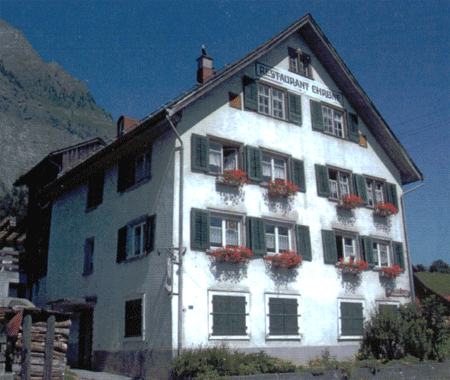Portrait
The mountain village Schwändi is located on the mining waste of a prehistoric landslide between the Guppen- and Hansli gully at the foot of the Vorderglärnisch. The municipality consists of Ober - and Unterschwändi, as well as the hamlet of Lassi(n)gen. The name Obermitlödi (Ober-Mitledin) which may have evolved into Schwändi appears for the first time in a rent-roll of the Säckingen abbey (written around 1300). The name Swendi is mentioned the first time in writing in the middle of the 14th century. The name means the place where it was cleared. In the rent-roll of the church Schwanden, dated 1523, the still existing field names Wingällen, im Grund, Schupfen, Flecken, Schiben, Spicher, Bort, Faden and Schlatt appear under the notation "on Schwändi". In addition, the document contains the no longer common names Niderdorf, Brenndli, Nellenbühl, Stilacker, Zägen and Baumgarten.
The village belonged first to the church in Glarus and since 1349 to the church in Schwanden. Since 1528 the majority of the people are Protestants.
Together with Mitlödi and Sool, Schwändi formed a so-called Wahltagwen (citizen's voting community). Moreover, until 1769 the citizens from Schwändi owned together with the citizens from Sool and Mitlödi common woodland. In 1701, Schwändi counted 22 male Protestants and in the middle of the same century there were 164 persons living in Schwändi. Shortly before 1800, already 530 persons lived there on the "sun terrace".
From the high middle ages on, the small livestock, which was operated aside after the emergence of cotton hand spinning at the beginning of the 18th century, dominated the professional life in Schwändi. Also in the 19th century, goat farming and wild haying were the most important sideline for the residents of Schwändi who mainly worked as textile workers outside the village. The total number of residents in Schwändi had grown to nearly 850 in 1860. The acute housing shortage at that time led to the construction of terraced houses in the Schibli and Neuhaus area.
Since 1785, evidence of a school in the village is given and in 1835, Schwändi finished the construction of the primary school. Schwändi was also the home of the poet Caspar Schiesser (1812-1839).
Extreme poverty prevailed at the beginning and in the middle of the 19th century. Besides the forest, the village has no resources. Moreover, as long as anyone can remember, landslides and avalanches caused massive damages in Schwändi. In 1845, the road to Schwanden was built (since 1960 there is a bus operating there) and in 1870, the road to Glarus was opened.
Since the beginning of the 20th century, there were ski racings in the village. Schwändi established itself as a health resort and operated seven hotels and guest houses with four saloons. in 1933, volunteers built a small swimming pool. In the 1980s and 1990s numerous newcomers were registered in Schwändi; the population therefore increased in this period from 276 to over 400.
A natural phenomenon occurs each year on the 24th of February. Then, the sun rises at 8 am in the morning in the Loch (hole), the deep cut between Foo- and Gandstock, and shines then continuously until 3.30 pm.
Only since the Swiss national exhibition in 1939, Schwändi has an own coat of arms. The creator Ida Tschudi probably relied on her namesake, Ägidius Tschudi, the famous Glarus chronicler of the 16th century. According to him, the Zurich Councilor family Schwend, which is proven in documents since 1300, originated from Schwändi. Already these members of the urban leadership group wore two roses with crossed stalks in their coat of arms, like centuries later the village Schwändi. The seven old citizen families Baumgartner, Jenny, Knobel, Schiesser, Schindler, Störi and Zimmermann were not considered in the selection of subjects.
Also in the tradition of Ägidius Tschudi, Professor Andreas Baumgartner (1844-1936), who grew up in the village of Schwändi as a citizen, referred in 1926 on a tradition of his ancestors, that a castle would have once been built above Schupfen on the way to Dicken. Anyway, no excavations were undertaken and in a call to the Glarus Burgenfreunde (the friends of Glarus castles) the author came to the conclusion that no castle ever was built in Schwändi.
In 2011, the community structure of canton Glarus was reorganized and Schwändi became part of the new administrative community Glarus Süd.
Translation of the official website of Schwändi








